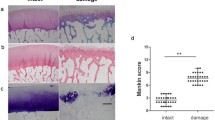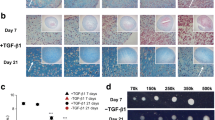Abstract
Chondroid cell from human adipose-derived stem cells (ADSCs) has emerged as an alternative treatment option for articular cartilage defects. Herein, we successfully compared ADSCs, normal chondrocytes, and chondroid cells. The comparative study of ADSCs and chondroid cells revealed type II collagen (COL II) and glycosaminoglycans expression of chondroid cells were similar to those in normal chondrocytes, and much higher than ADSCs. Using atomic force microscope (AFM) and laser confocal scanning microscopy (LCSM), we compared the differences in morphology, mechanical properties, and F-actin distribution between chondroid cells and normal chondrocytes. Our results showed no differences observed between these two types of cells regarding morphology, stiffness, and F-actin distribution. However, found that the adhesion force in chondroid cells was lower than that in normal chondrocytes. Taken together, our AFM and LCSM analyses suggest that the lower adhesion force in chondroid cells may contribute to the dedifferentiation of ADSC-derived chondroid cells. Future examination of surface adhesion force-related protein expression will likely provide new insight into the molecular mechanisms underlying the dedifferentiation of ADSC-derived chondroid cells.




Similar content being viewed by others
References
Vinatier C, Mrugala D, Jorgensen C, Guicheux J, Noel D (2009) Cartilage engineering: a crucial combination of cells, biomaterials and biofactors. Trends Biotechnol 27:307–314
Jiang YZ, Zhang SF, Qi YY, Wang LL, Ouyang HW (2011) Cell transplantation for articular cartilage defects: principles of past, present and future practice. Cell Transplant 20:593–607
Hwang NS, Varghese S, Lee HJ, Zhang Z, Ye Z, Bae J, Cheng L, Elisseeff J (2008) In vivo commitment and functional tissue regeneration using human embryonic stem cell-derived mesenchymal cells. Proc Natl Acad Sci USA 105:20641–20646
Waese EY, Stanford WL (2011) One-step generation of murine embryonic stem cell-derived mesoderm progenitors and chondrocytes in a serum-free monolayer differentiation system. Stem Cell Res 6:34–49
Wakitani S, Takaoka K, Hattori T, Miyazawa N, Iwanaga T, Takeda S, Watanabe TK, Tanigami A (2003) Embryonic stem cells injected into the mouse knee joint form teratomas and subsequently destroy the joint. British Society for Rheumatology 42:162–165
Nakao N, Nakayama T, Yahata T, Muguruma Y, Saito S, Miyata Y, Yamamoto K, Naoe T (2010) Adipose tissue-derived mesenchymal stem cells facilitate hematopoiesis in vitro and in vivo: advantages over bone marrow-derived mesenchymal stem cells. Am J Pathol 177:547–554
Kim B-S, Kang K-S, Kang S-K (2010) Soluble factors from ASCs effectively direct control of chondrogenic fate. Cell Prolif 43:249–261
Jeong JH, Lee JH, Jin ES, Min JK, Jeon SR, Choi KH (2010) Regeneration of intervertebral discs in a rat disc degeneration model by implanted adipose-tissue-derived stromal cells. Acta Neurochir 152:1771–1777
Estes BT, Diekman BO, Gimble JM, Guilak F (2010) Isolation of adipose-derived stem cells and their induction to a chondrogenic phenotype. Nat Protoc 5:1294–1311
Mahmoudifar N, Doran PM (2010) Chondrogenic differentiation of human adipose-derived stem cells in polyglycolic acid mesh scaffolds under dynamic culture conditions. Biomaterials 31:3858–3867
Vadillo-Rodriguez V, Beveridge TJ, Dutcher JR (2008) Surface viscoelasticity of individual gram-negative bacterial cells measured using atomic force microscopy. J Bacteriol 190:4225–4232
Simon A, Cohen-Bouhacina T, Aime JP, Porte MC, Amedee J, Baquey C (2004) Heterogeneous cell mechanical properties: an atomic force microscopy study. Cell Mol Biol 50:255–266
Janmey PA, McCulloch CA (2007) Cell mechanics: integrating cell responses to mechanical stimuli. Annu Rev Biomed Eng 9:1–34
Cross SE, Jin YS, Rao J, Gimzewski JK (2007) Nanomechanical analysis of cells from cancer patients. Nat Nanotechnol 2:780–783
Kotova S, Prasad K, Smith PD, Lafer EM, Nossal R, Jin AJ (2010) AFM visualization of clathrin triskelia under fluid and in air. FEBS Lett 584:44–48
Barth S, Harnagea C, Mathur S, Rosei F (2009) The elastic moduli of oriented tin oxide nanowires. Nanotechnology 20:115705
Baclayon M, Roos WH, Wuite GJ (2010) Sampling protein form and function with the atomic force microscope. Mol Cell Proteomics 9:1678–1688
Deng Z, Zink T, Chen HY, Walters D, Liu FT, Liu GY (2009) Impact of actin rearrangement and degranulation on the membrane structure of primary mast cells: a combined atomic force and laser scanning confocal microscopy investigation. Biophys J 96:1629–1639
Jin H, Xing X, Zhao H, Chen Y, Huang X, Ma S, Ye H, Cai J (2010) Detection of erythrocytes influenced by aging and type 2 diabetes using atomic force microscope. Biochem Biophys Res Commun 391:1698–1702
Liu S, Wang Y (2010) Application of AFM in microbiology: a review. Scanning 32:61–73
Malicev E, Kregar-Velikonja N, Barlic A, Alibegovic A, Drobnic M (2009) Comparison of articular and auricular cartilage as a cell source for the autologous chondrocyte implantation. J Orthop Res 27:943–948
Langelier E, Suetterlin R, Hoemann CD, Aebi U, Buschmann MD (2000) The chondrocyte cytoskeleton in mature articular cartilage: structure and distribution of actin, tubulin, and vimentin filaments. J Histochem Cytochem 48:1307–1320
Hamilton DW, Riehle MO, Monaghan W, Curtis AS (2005) Articular chondrocyte passage number: influence on adhesion, migration, cytoskeletal organisation and phenotype in response to nano- and micro-metric topography. Cell Biol Int 29:408–421
Sasazaki Y, Seedhom BB, Shore R (2008) Morphology of the bovine chondrocyte and of its cytoskeleton in isolation and in situ: are chondrocytes ubiquitously paired through the entire layer of articular cartilage? Rheumatology 47:1641–1646
Wakatsuki T, Schwab B, Thompson NC, Elson EL (2001) Effects of cytochalasin D and latrunculin B on mechanical properties of cells. J Cell Sci 114:1025–1036
Tseng Y, Wirtz D (2001) Mechanics and multiple-particle tracking microheterogeneity of alpha-actinin-cross-linked actin filament networks. Biophys J 81:1643–1656
Zhang H, Bremmell KE, Smart RS (2005) Direct measurement of interactions between adsorbed vitronectin layers: the influence of ionic strength and pH. J Biomed Mater Res A 74:59–68
Kim H, McCulloch CA (2011) Filamin A mediates interactions between cytoskeletal proteins that control cell adhesion. FEBS Lett 585:18–22
Hynes RO (1992) Integrins: versatility, modulation, and signaling in cell adhesion. Cell 69:11–25
Goessler UR, Bieback K, Bugert P, Heller T, Sadick H, Hormann K, Riedel F (2006) In vitro analysis of integrin expression during chondrogenic differentiation of mesenchymal stem cells and chondrocytes upon dedifferentiation in cell culture. Int J Mol Med 17:301–307
Kurtis MS, Schmidt TA, Bugbee WD, Loeser RF, Sah RL (2003) Integrin mediated adhesion of human articular chondrocytes to cartilage. Arthritis Rheum 48:110–118
Lee JW, Qi WN, Scully SP (2002) The involvement of beta1 integrin in the modulation by collagen of chondrocyte-response to transforming growth factor-beta1. J Orthop Res 20:66–75
Raducanu A, Hunziker EB, Drosse I, Aszodi A (2009) Beta1 integrin deficiency results in multiple abnormalities of the knee joint. J Biol Chem 284:23780–23792
Wang W, Kirsch T (2006) Annexin V/beta5 integrin interactions regulate apoptosis of growth plate chondrocytes. J Biol Chem 281:30848–30856
Hsieh CH, Lin YH, Lin S, Tsai-Wu JJ, Herbert Wu CH, Jiang CC (2008) Surface ultrastructure and mechanical property of human chondrocyte revealed by atomic force microscopy. Osteoarthr Cartil 16:480–488
Titushkin I, Cho M (2007) Modulation of cellular mechanics during osteogenic differentiation of human mesenchymal stem cells. Biophys J 93:3693–3702
Angker L, Nijhof N, Swain MV, Kilpatrick NM (2004) Influence of hydration and mechanical characterization of carious primary dentine using an ultra-micro indentation system (UMIS). Eur J Oral Sci 112:231–236
Wozniak MJ, Kawazoe N, Tateishi T, Chen G (2009) Monitoring of mechanical properties of serially passaged bovine articular chondrocytes by atomic force microscopy. Micron 40:870–875
Oberleithner H (2005) Aldosterone makes human endothelium stiff and vulnerable. Kidney Int 67:1680–1682
Cai Xiaofang, Gao Shijun, Jiye Cai, Wu Y, Deng H (2009) Artesunate Induced Morphological and Mechanical Changes of Jurkat Cell Studied by AFM. Scanning 31:83–89
Acknowledgments
This work was supported by Guangdong Provincial Science and Technology Project of China (2011B031800066, 2010B031600105), Guangdong Provincial Medical Scientific Research Foundation (B2011161) and the Fundamental Research Funds for the Central Universities.
Author information
Authors and Affiliations
Corresponding author
Additional information
Simin Luo and Qiping Shi contribute equally to this paper.
Rights and permissions
About this article
Cite this article
Luo, S., Shi, Q., Zha, Z. et al. Morphology and mechanics of chondroid cells from human adipose-derived Stem cells detected by atomic force microscopy. Mol Cell Biochem 365, 223–231 (2012). https://doi.org/10.1007/s11010-012-1263-5
Received:
Accepted:
Published:
Issue Date:
DOI: https://doi.org/10.1007/s11010-012-1263-5




